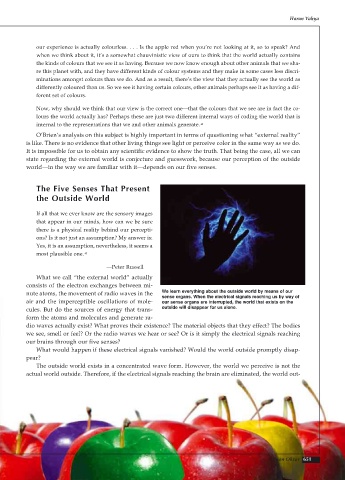Page 653 - Atlas of Creation Volume 4
P. 653
Harun Yahya
our experience is actually colourless. . . . Is the apple red when you’re not looking at it, so to speak? And
when we think about it, it’s a somewhat chauvinistic view of ours to think that the world actually contains
the kinds of colours that we see it as having. Because we now know enough about other animals that we sha-
re this planet with, and they have different kinds of colour systems and they make in some cases less discri-
minations amongst colours than we do. And as a result, there’s the view that they actually see the world as
differently coloured than us. So we see it having certain colours, other animals perhaps see it as having a dif-
ferent set of colours.
Now, why should we think that our view is the correct one—that the colours that we see are in fact the co-
lours the world actually has? Perhaps these are just two different internal ways of coding the world that is
internal to the representations that we and other animals generate. 42
O’Brien’s analysis on this subject is highly important in terms of questioning what “external reality”
is like. There is no evidence that other living things see light or perceive color in the same way as we do.
It is impossible for us to obtain any scientific evidence to show the truth. That being the case, all we can
state regarding the external world is conjecture and guesswork, because our perception of the outside
world—in the way we are familiar with it—depends on our five senses.
The Five Senses That Present
the Outside World
If all that we ever know are the sensory images
that appear in our minds, how can we be sure
there is a physical reality behind our percepti-
ons? Is it not just an assumption? My answer is:
Yes, it is an assumption, nevertheless, it seems a
most plausible one. 43
—Peter Russell
What we call “the external world” actually
consists of the electron exchanges between mi-
We learn everything about the outside world by means of our
nute atoms, the movement of radio waves in the
sense organs. When the electrical signals reaching us by way of
air and the imperceptible oscillations of mole- our sense organs are interrupted, the world that exists on the
outside will disappear for us alone.
cules. But do the sources of energy that trans-
form the atoms and molecules and generate ra-
dio waves actually exist? What proves their existence? The material objects that they effect? The bodies
we see, smell or feel? Or the radio waves we hear or see? Or is it simply the electrical signals reaching
our brains through our five senses?
What would happen if these electrical signals vanished? Would the world outside promptly disap-
pear?
The outside world exists in a concentrated wave form. However, the world we perceive is not the
actual world outside. Therefore, if the electrical signals reaching the brain are eliminated, the world out-
Adnan Oktar 651

